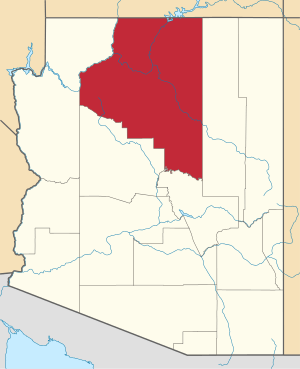Grand Canyon Village, Arizona
Grand Canyon Village is a census-designated place (CDP) located on the South Rim of the Grand Canyon, in Coconino County, Arizona, in the United States. Its population was 2,004 at the 2010 Census.[4] Located in Grand Canyon National Park, it is wholly focused on accommodating tourists visiting the canyon. Its origins trace back to the railroad completed from Williams, Arizona, to the canyon's South Rim by the Santa Fe Railroad in 1901. Many of the structures in use today date from that period. The village contains numerous landmark buildings, and its historic core is a National Historic Landmark District, designated for its outstanding implementation of town design.
Grand Canyon Village, Arizona | |
|---|---|
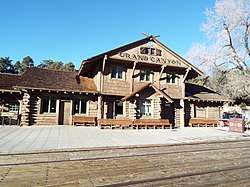 Historic Grand Canyon Railroad Depot | |
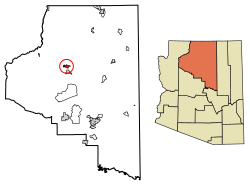 Location of Grand Canyon Village in Coconino County, Arizona | |
 Grand Canyon Village, Arizona Location in the United States | |
| Coordinates: 36°03′20.5″N 112°08′31.7″W | |
| State | Arizona |
| County | Coconino County |
| Area | |
| • Total | 13.40 sq mi (34.71 km2) |
| • Land | 13.40 sq mi (34.71 km2) |
| • Water | 0.00 sq mi (0.00 km2) |
| Elevation | 6,804 ft (2,074 m) |
| Population (2010) | |
| • Total | 2,004 |
| • Estimate (2016)[3] | N/A |
| • Density | 22.2/sq mi (57.74/km2) |
| Time zone | UTC-7 (MST) |
| Area code(s) | 928 |
| FIPS code | 04-2408314 |
| GNIS feature ID | 2408314[2] |
Geography and transportation
According to the United States Census Bureau, the CDP has a total area of 13.4 square miles (35 km2), all of it land.[5]
It is located 180 miles (290 km) north of Phoenix,[6] and 168 miles (270 km) from Las Vegas.[7]
Grand Canyon Shuttle operates airport shuttles 24/7 on the North and South Rim from Phoenix Sky Harbor International Airport.[8]
The Grand Canyon Railway connects the Grand Canyon Depot in Grand Canyon Village with the Williams Depot in Williams, Arizona. Connections were offered to Amtrak's Williams Junction station until 2017, when the station was closed.
The National Park Service operates free shuttle buses on the South Rim.[9]
Demographics
As of the census of 2000, there were 1,460 people, 651 households, and 345 families residing in the CDP. The population density was 108.6 people per square mile (41.9/km2). There were 791 housing units at an average density of 100.8 per square mile (22.7/km2). The racial makeup of the CDP was 73.7% White, 1.6% Black or African American, 18.8% Native American, 0.9% Asian, 0.3% Pacific Islander, 1.9% from other races, and 2.9% from two or more races. 10.2% of the population were Hispanic or Latino of any race.[10]
There were 651 households, out of which 24.9% had children under the age of 18 living with them, 42.1% were married couples living together, 6.0% had a female householder with no husband present, and 46.9% were non-families. 31.6% of all households were made up of individuals, and 0.9% had someone living alone who was 65 years of age or older. The average household size was 2.18 and the average family size was 2.84.
In the CDP, the population was spread out, with 20.5% under the age of 18, 8.4% from 18 to 24, 41.2% from 25 to 44, 27.7% from 45 to 64, and 2.2% who were 65 years of age or older. The median age was 37 years. For every 100 females, there were 114.7 males. For every 100 females age 18 and over, there were 110.1 males.
The median income for a household in the CDP was $42,083, and the median income for a family was $53,676. Males had a median income of $28,750 versus $23,565 for females. The per capita income for the CDP was $19,923. About 1.7% of families and 4.8% of the population were below the poverty line, including 4.9% of those under age 18 and none of those age 65 or over.
Media
KUGO 102.5 FM is licensed to Grand Canyon Village, and broadcasts travelers' information for visitors to the Grand Canyon.[11]
Education
The area is served by the Grand Canyon Unified School District.
Historic structures and monuments
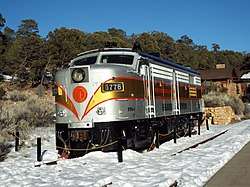
The following is a brief description the images of some of the historic structures and plaques in the Grand Canyon Village.[12][13][14]
- The Grand Canyon Railroad Depot – the depot was built in 1901 and is within the Grand Canyon Village Historic District. It is one of three remaining railroad depots in the United States built with logs as the primary material. It was listed in the National Register of Historic Places on September 6, 1974, reference #74000343. It was declared a National Historic Landmark on May 28, 1987.
- The Horace M. Albright Training Center – the training center was established in 1963, and is located on Albright Street within the South Rim of the Grand Canyon. It is the primary training facility for new permanent NPS employees.
- El Tovar Hotel – was built in 1903 and operated by the Fred Harvey Company. It is located in the Grand Canyon National Park, Rte 8A. It was listed in the National Register of Historic Places on September 6, 1974, reference #74000334. It was declared a National Historic Landmark on May 28m 1987.
- El Tovar Stables – were built in 1904 and is located in the Grand Canyon National Park, Rte 8A. It was listed in the National Register of Historic Places on September 6, 1974, reference #74000336.
- AT& SF Employee residence – the employee residences were built between 1924 and 1933. The residence pictured is located on Apache Street in the Grand Canyon National Park.
- The Grand Canyon Power House – the power house was built in 1926 and located in the Grand Canyon National Park. It was Designated a National Landmark and listed in the National Register of Historic Places on May 28, 1987, reference #87001411.
- The Bright Angel Lodge – the lodge was built in 1935. It was designed by architect Mary Jane Colter and is located within the Grand Canyon Village Historic District.
- The Buck O’Neil Cabin – the cabin was built in 1890 by William “Buckey” O’Neil. Among the occupations which O’Neil had during his lifetime were that author, sheriff and judge in Arizona. He was a member of the Rough Riders and in Cuba he was killed in action. The cabin is the oldest extant structure on the South Rim.
- The Hopi House – built in 1904, by the Fred Harvey Company and designed by architect Mary Jane Colter. It is located within the Grand Canyon Village Historic District. It was Designated a National Landmark and listed in the National Register of Historic Places on May 28, 1987, reference #87001436.
- The Look-Out Studio – designed by architect Mary Jane Colter it was built in 1914. It is located within the Grand Canyon Village Historic District. It was Designated a National Landmark and listed in the National Register of Historic Places on May 28, 1987, reference #87001436.
- The Kolb Studio – a historic structure situated on the edge of the South Rim of the Grand Canyon in Grand Canyon Villagewithin Grand Canyon National Park in Arizona. It was operated from 1904 until 1976 as the photographic studio of brothers Ellsworth and Emery Kolb.
- Verkamp’s Curio Store – built in 1906, is now Verkamp’s Visitor Center, and is operated by the Grand Canyon Conservancy for the National Park Service. Built by Ohioan John George Verkamp, who sold Native American crafts and souvenirs, the two-story shingled building has been described as “modified Mission” style, resembling an adobe building in form if not materials.
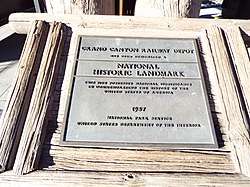 Canyon Railroad Depot National Historic Landmark Marker
Canyon Railroad Depot National Historic Landmark Marker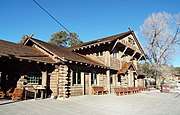 Different view Canyon Railroad Depot
Different view Canyon Railroad Depot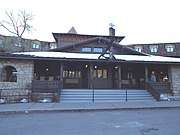 El Tovar Hotel
El Tovar Hotel The Bright Angel Lodge
The Bright Angel Lodge William “Buckey” O’Neil's Cabin
William “Buckey” O’Neil's Cabin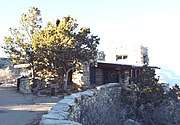 The Look-Out Studio
The Look-Out Studio
References
- "2016 U.S. Gazetteer Files". United States Census Bureau. Retrieved Jul 18, 2017.
- U.S. Geological Survey Geographic Names Information System: Grand Canyon Village, Arizona
- "Population and Housing Unit Estimates". Retrieved June 9, 2017.
- "Profile of General Population and Housing Characteristics: 2010 Demographic Profile Data (DP-1): Grand Canyon Village CDP, Arizona". United States Census Bureau. Retrieved December 8, 2011.
- "Grand Canyon Village CDP, Arizona – Basic Facts". AZ Hometown Locator. Retrieved November 22, 2016.
- "Distance from Phoenix, AZ to Grand Canyon Village, AZ". check-distance.com. Retrieved 2019-02-14.
- "Distance from Las Vegas, NV to Grand Canyon Village, AZ". check-distance.com. Retrieved 2019-02-14.
- Grand Canyon Shuttle
- South Rim Shuttle Bus Routes
- "U.S. Census website". United States Census Bureau. Retrieved 2008-01-31.
- KUGO-FM 102.5 MHz, radio-locator.com. Retrieved August 12, 2020.
- Training
- National Register of Historic Places
- The Gran Canyon Diesel Fleet
